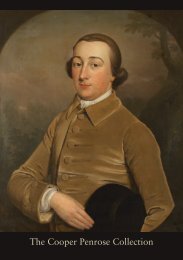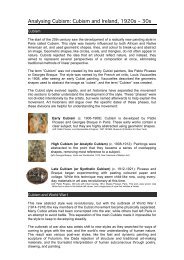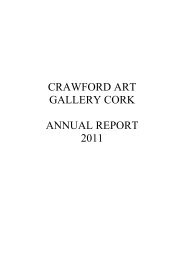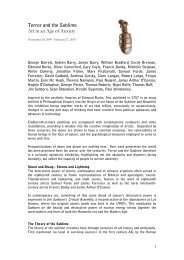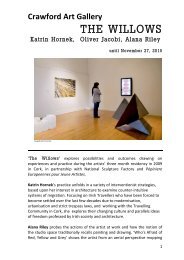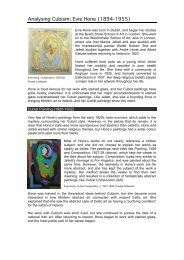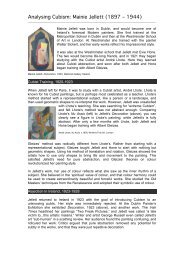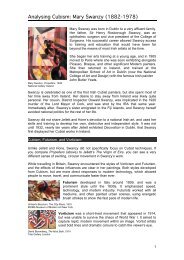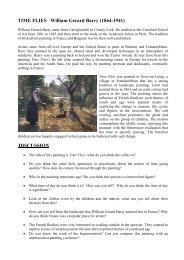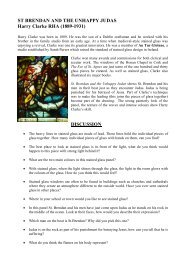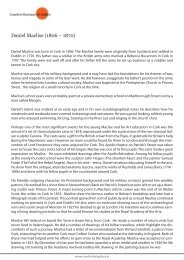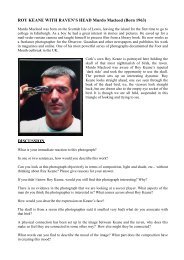Laocoon and his Sons.pdf - Crawford Art Gallery
Laocoon and his Sons.pdf - Crawford Art Gallery
Laocoon and his Sons.pdf - Crawford Art Gallery
You also want an ePaper? Increase the reach of your titles
YUMPU automatically turns print PDFs into web optimized ePapers that Google loves.
LAOCOON AND HIS SONS. The Canova Casts<br />
(Presented 1818)<br />
In 1818, the gift of the Canova Casts from the Prince Regent to Lord Listowel was a catalyst for the<br />
foundation of the first School of <strong>Art</strong> in Cork. Pope Pius VII had originally gifted the casts to<br />
Britain in gratitude for British help with the return of Vatican treasures taken by Napoleon. Some<br />
two hundred pieces cast from the finest sculptures in the Vatican arrived in Cork to inspire future<br />
artists such as Daniel Maclise, Samuel Forde, <strong>and</strong> John<br />
Hogan. The famed Italian sculptor, Antonio Canova,<br />
had overseen the return of the treasures <strong>and</strong> supervised<br />
the casting of the masterpieces. Some of <strong>his</strong> works are<br />
included in the collection. The casts have had an<br />
eventful <strong>and</strong> chequered <strong>his</strong>tory, <strong>and</strong> a number of the<br />
finest remain in the <strong>Crawford</strong> Collection.<br />
<strong>Laocoon</strong> <strong>and</strong> His <strong>Sons</strong> is a cast made from an original<br />
marble sculpture found in Rome in 1506. The find was<br />
made in the ruins of the palace of Titus <strong>and</strong> was one of<br />
the major discoveries of the Italian Renaissance. The<br />
piece is believed to have been carved in Greece by<br />
three sculptors; Hages<strong>and</strong>ros, Polydoros <strong>and</strong><br />
Athenkodors, the original is in the Vatican Museums.<br />
The scene of the Trojan priest <strong>Laocoon</strong> <strong>and</strong> <strong>his</strong> sons<br />
being strangled by sea monsters is vigorously depicted<br />
by writhing, twisting figures. <strong>Laocoon</strong> had incurred the<br />
wrath of the Gods when he tried to warn the people of<br />
Troy of <strong>his</strong> suspicions about the Trojan horse. The God<br />
Apollo, who favoured the Greeks, sent the serpents to<br />
attack <strong>Laocoon</strong> <strong>and</strong> <strong>his</strong> sons as they were making a sacrifice at the altar of Neptune.<br />
DISCUSSION<br />
• What is your first reaction to t<strong>his</strong> sculpture<br />
• Does the violence of the incident come across in the action of the figures Where do you see<br />
t<strong>his</strong><br />
• In the figure of <strong>Laocoon</strong>, look at sections of <strong>his</strong> legs, <strong>his</strong> torso, <strong>his</strong> arms, each section seems<br />
to be strained <strong>and</strong> pained, where is t<strong>his</strong> especially true<br />
• Look at the face of <strong>Laocoon</strong>, what do you read from <strong>his</strong> expression<br />
• Try making t<strong>his</strong> face <strong>and</strong> stretching your neck like <strong>Laocoon</strong> does.<br />
• Does t<strong>his</strong> feel like pain or anger or something else to you<br />
• The drama of the piece is almost theatrical, can you identify the movements <strong>and</strong> poses that<br />
give t<strong>his</strong> sense of the theatrical to the group<br />
• The sea serpents bring your eye around the sculpture group, what else draws your eye<br />
around
• The main thrust of the sculptural group is towards the left, with one figure pulling away<br />
towards the right, what does t<strong>his</strong> figure on the right do to the balance of the sculpture<br />
Imagine how the sculpture would look without t<strong>his</strong> figure, would it have the same impact<br />
• Do you think the work was designed to be seen from behind or not<br />
The original sculpture had to be pieced back<br />
together when it was found during the Italian<br />
Renaissance. <strong>Art</strong>ists at the time agreed on the<br />
version seen before, but later the original arm was<br />
found <strong>and</strong> t<strong>his</strong> more accurate version was<br />
assembled.<br />
• How is the dynamic changed by the new<br />
arrangement of the sculpture<br />
• If you stretch into the individual poses,<br />
which one seems more real<br />
IN THE GALLERY<br />
<strong>Laocoon</strong> <strong>and</strong> <strong>his</strong> <strong>Sons</strong> is one of many classical casts in plaster to be found in t<strong>his</strong> room. One of the<br />
great benefits of having these figurative works was that art students traditionally drew from them to<br />
study human anatomy. Find an interesting (<strong>and</strong> comfortable) viewpoint <strong>and</strong> see how t<strong>his</strong> would<br />
work, better still, do some sketching.<br />
HANDS ON<br />
In class, take an example (perhaps from your English play or prose) of conflict between two or three<br />
people. Imagine a group acting out t<strong>his</strong> conflict. Chose poses that work to express each individual<br />
position <strong>and</strong> try to show the group dynamic. Create a tableau - a living picture, where you direct a<br />
group of pupils in your class to remain frozen in the poses of your characters. Draw or photograph<br />
t<strong>his</strong> group <strong>and</strong> you could also use it as a basis for a sculpture.



